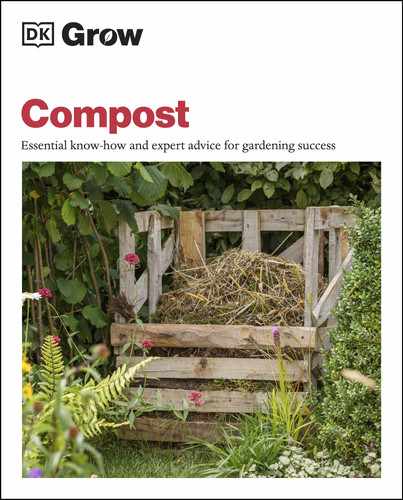PLANTING ON YOUR COMPOST HEAP
Once your heap has started to cool down and mature, you can plant crops or flowers directly on it to take advantage of the warmth and fertility of the compost. This is a great way to boost the productivity of your plot and provide a banquet for beneficial insects while your compost matures. Some plants, such as tomatoes, may appear without any help from you, their seeds deposited in bird droppings.
WHAT TO PLANT
Numerous plants and crops will thrive on a compost heap. Nasturtiums often spring up of their own accord from seeds in old potting mixes added to the heap, or through bird droppings. If so, consider yourself fortunate: their flowers will attract pollinators into your garden, and both their blooms and leaves are edible, adding a spicy kick to salads. If you want to continue the floral theme, try plunging biodegradable pots of petunias and sunflowers into the mix to create a flowery heap—the pots soon break down, allowing the roots to escape and soak up the nutrients.
If you are more interested in edible crops, try planting melons, zucchini, pumpkins, eggplant, and trailing tomatoes, such as small cherry types. These fruiting vegetables love the warmth and fertility of a compost heap, and once established will soon form large, productive plants. They all require sun, however, so this idea is only recommended if your heap is situated in a warm, sunny, and sheltered spot.

Nasturtiums will form a carpet of edible leaves and flowers on the top of a bin.

Winter and summer squashes enjoy the rich fertility of a compost heap.
HOW TO PLANT
After your bin or heap is full, wait at least two months before planting. It is best to plant seedlings rather than sow seeds directly in the heap, because the fertile compost will reduce germination rates. Sow seeds of your chosen crops and flowers indoors in spring, and plant them out once they are well established; you may have to pot them a couple of times after sowing. Water your plants, just as if you were growing them in soil. Once your crops are harvested or the flowers finished, turn the plants back into the pile to be composted.

A layer of straw will help to keep zucchini fruits dry as they develop.

The compost heap is an ideal place to accommodate large plants, such as zucchini, that you might otherwise struggle to fit into your plot.
Using Compost | PLANTING ON YOUR COMPOST HEAP
NEED TO KNOW
- Place your bin or heap in a warm, sunny spot, especially if you want to grow vegetables on it.
- Only use a full bin that has already heated up and cooled down; you may burn the roots of crops if they are planted on the heap too early in the composting process.
- Plant tender seedlings only when the risk of frost has passed.
- Young plants may be vulnerable to slug damage in a compost heap, so wait until their stems have toughened up before planting them.
